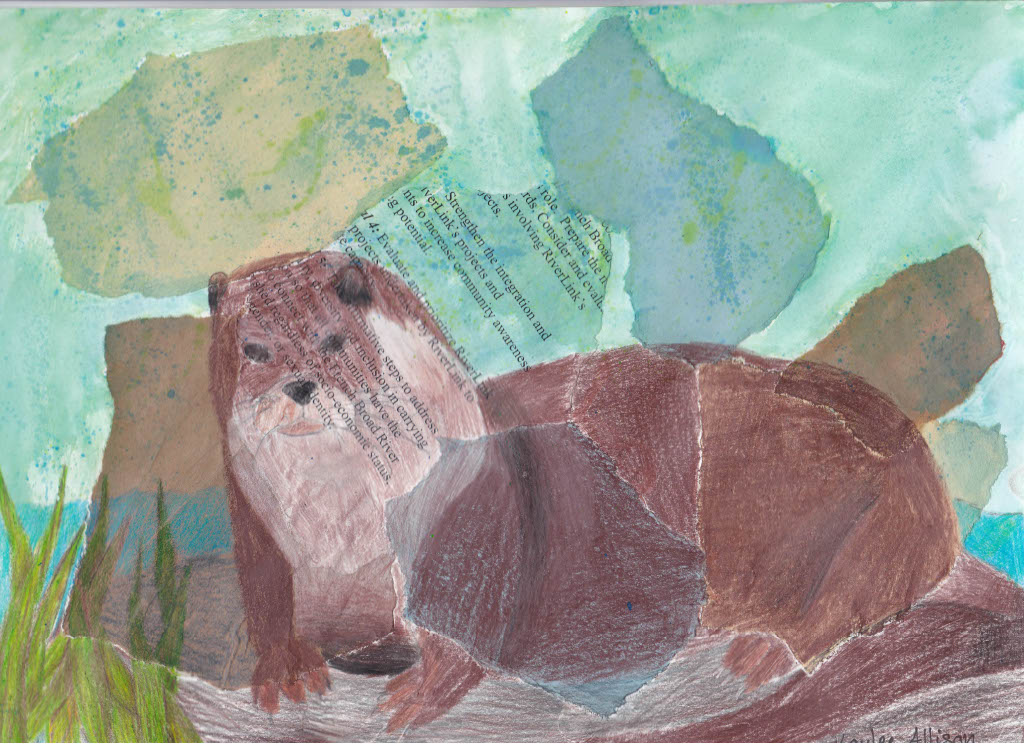 | Learn to Love the River Discover what makes the French Broad River so special and learn about the many ways it connects our community. | | | | | | | | | | We’ve learned about dragonflies, kingfishers, hellbenders, and caddisflies. Our waters are full of fascinating aquatic life! Today we are going to talk about RiverLink’s very own mascot, the river otter. We hope you enjoy and learn something new! | | | | History, Habitat & Habits | | | | Did you know that river otters were once abundant in Western North Carolina? In fact, before colonization, river otters were thriving in our region. River otters faced a population decline due to habitat destruction and fur-trapping but have returned to stable levels thanks to conservation efforts of the NC Wildlife Commision. By restoring the river otter population, North Carolina also successfully revitalized the wild turkey population! In an unusual trade between states, North Carolina traded river otters to West Virginia for wild turkeys. By doing so, the river otters indirectly assisted in the reintroduction of wild turkeys in North Carolina. Thanks to the restoration efforts, we are lucky to continue to have these awesome creatures in our region. River otters are aquatic predators and their diet consists mostly of fish, crayfish, crabs, and amphibians. River otters have a surprisingly long life expectancy of 10-15 years! They can swim forwards and backwards with ease and can live in a variety of habitats ranging from warm coastal streams and marshes to cold and fast moving mountain streams. Sometimes otters lock arms or hold paws so they can stick together and don’t float away from each other. River otters are found throughout most of North America from the Rio Grande to Canada and Alaska. They can be found in riparian zones, similar to where beavers make their homes. Their aquatic habitats can be both marine and freshwater: streams, rivers, lakes, ponds and marshes. | | | | | | | | When you go swimming, what do you wear? A bathing suit since your regular clothes aren’t supposed to get wet, some goggles to help you see underwater, a snorkel so you can breathe, and maybe flippers to help you swim faster. All of these items help us while in the water, so we’re better adapted to an aquatic environment. River otters have some special adaptations too! Awesome Otter Adaptations: - An otter’s eyes, ears, and nose are positioned high on their head so that their body can be submerged while they still breathe, see, and hear above water.
- When they dive under the water, they can close up their ears and nose so water doesn’t get in.
- A long and narrow body allows them to move faster through the water.
- Webbed feet with 5 toes and a long, flat tail also help them move faster through the water and make sharp turns while hunting.
- Sharp claws are especially useful for grasping fish!
- Special pads on their back feet give them a better grip on slippery surfaces.
Fur is especially important for otters! - A dense inner layer keeps them warm, and a waterproof outer layer keeps the inner layer and their skin dry.
- Air gets trapped between the layers to provide more insulation.Sometimes while they are swimming you can see a trail of bubbles behind them as the air gets released!
- Darker brown fur on their backs means they blend in with the darker water when looked at from above while swimming.
- Lighter brown fur on their stomachs helps them blend with the lighter sky when looked at from below.
| | | | | | Is it a Sea Otter or a River Otter? | | | | River otters and sea otters are often mistaken for each other. Here we will look at some of the characteristics of each so you can become an otter identifying expert! To start, sea otters are 2-3 times bigger than river otters. Another determining factor is the way the different otters swim. While sea otters float on their backs, river otters swim with their bellies down and in the water. You can also tell sea otters and river otters apart by their tails. A sea otter's tail is short and flattened, whereas a river otter’s tail is long and pointed. Also, sea otters spend the majority of their time in the water. They breed, give birth, hunt for food and sleep in water. River otters on the other hand, live most of their lives on solid ground and use the water to travel and find food.
Check out this awesome identification brochure put together by the Seattle Aquarium if you want to learn more! | | | | | |  | Kaylee A., a 7th grade student from Charles D. Owen Middle School, submitted her art piece titled “River Otter” this year for our Voices of the River Art & Poetry Contest. | | | |  | | | | | | | Staying connected to the river and each other. We are thinking of you all in these uncertain times and hope you are staying healthy and safe! Thanks to your generous support we are able to continue our Education, Water Quality and Land Conservation programs, but we couldn't do it without you! | | | | | | | | | | | |